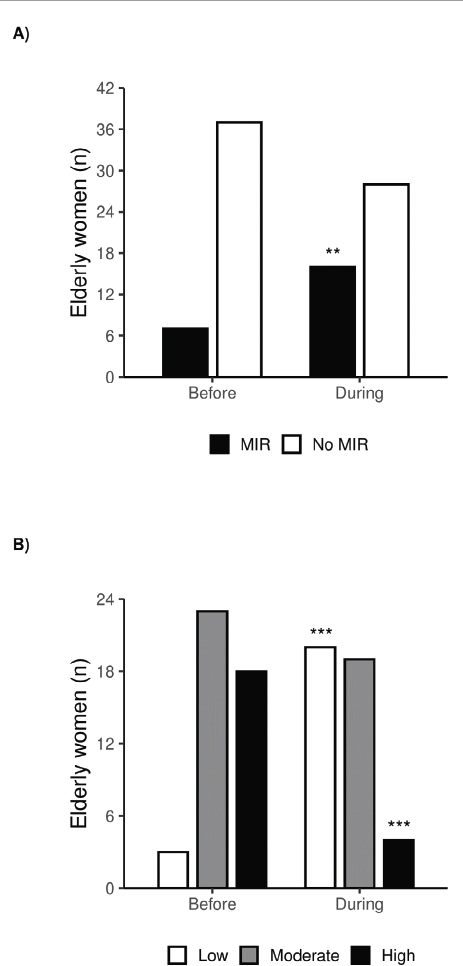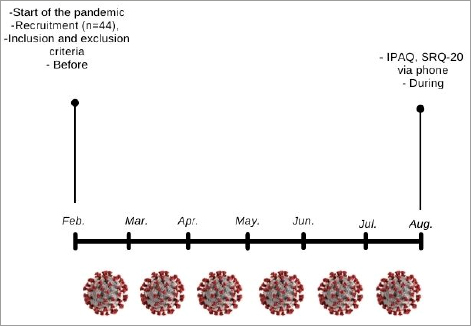INTRODUCTION
With the arrival of the pandemic of COVID-19 (Coronavirus Disease 2019) in Brazil, the virus has become a factor of illness for countless people, especially the elderly. This population is not only a risk group for COVID-19 but several other illnesses, such as some related to mental health (Ornell, Schuch, Sordi, & Kessler, 2020).
However, physical detachment was the primary preventive measure implemented by public health authorities, which, along with numerous other recurrent anxiogenic and stressful situations in the pandemic, may be factors responsible for an increase in mental/emotional suffering and mental disorders associated with the age group (WHO, 2019; Brooks et al., 2020). Among the several complicating factors, physical inactivity is mentioned as being a negative factor for the mental health of the elderly (Jurakić, Pedišić, & Greblo, 2010). Evidence has revealed that the pandemic environment is worrying because it reduces physical activity levels (PA levels), which contributes to an acceleration in deleterious processes associated with ageing and the progression of chronic diseases (Davies et al., 2019).
Besides, physical exercise in groups is considered by the elderly as a motivating and socialising moment, which contributes to mental health and quality of life. However, these practices are not feasible in the pandemic context, being a demotivating factor for the elderly to remain active at home and may put the mental health of these people at risk (Goethals et al., 2020). In this context, we identified the need to assess if the COVID-19 pandemic changed the level of physical activity in a group of elderly women and if these changes would affect their mental health.
Thus, the purpose of this study was to verify the effect of the COVID-19 pandemic on PA levels and mental illness risk (MIR) in elderly women and the association between these variables. We hypothesise that the COVID-19 pandemic will reduce the PA levels and increase the MIR of elderly women, and this worsening of mental health will be related to the decrease in physical activity practice.
METHODS
Subjects
This was an experimental, longitudinal study in which 44 elderly women with an average age of 67.3± 5.3 years were selected for convenience. The project was approved by the Human Research Ethics Committee of the Universidade Federal de Viçosa (UFV) (CAAE: 60303716.1.0000.5153). All elderly women agreed to participate in the study voluntarily.
Study protocol
For data collection, the Self-Reporting Questionnaire (SRQ-20) was used, which is validated in Brazil to screen MIR in primary care (Mari & Williams, 1986). The SRQ-20 consists of 20 dichotomous questions (yes or no), where the final score≥ 7 points to the assessed subject’s MIR. The PA levels were verified by applying the international physical activity questionnaire (IPAQ) validated for the Brazilian elderly (Benedetti et al., 2008). The instruments were applied in the form of interviews in two moments: in person (February 2020), just before the pandemic, and by telephone (August 2020) 20 weeks after implementing the social distance measures imposed to control the spreading of COVID-19. Figure 1 shows the flow chart of the follow-up of the study.
Statistical analysis
For the analysis of dichotomous data from MIR, we used the McNemar test. To calculate the effect size (ES), we used the relative risk (RR). For categorical LAP data, we applied the chi-square test (χ2). To calculate ES, we used Cramér’s V (V). Pearson’s bivariate linear correlation (r) was carried out between PA levels and MIR data in the moments before (February 2020) and during the pandemic (August 2020). To complement the ES of Person’s r, the determination coefficient (R2) was used to explain the percentage variation in the correlation between MIR and PA levels. The ES≥ 0.10 (small), ≥ 0.30 (moderate), and ≥ 0.50 (large) were considered for all analyses, according to Cohen’s standardisation (Cohen, 2013). The level of significance adopted for all analyses was p< 0.05. The R version 4.1.0 program was used with the help of Rstudio (Field et al., 2012).
RESULTS
There was a significant increase (128%) in the number of elderly women with ≥ 7 positive responses for the incidence of MIR between the two analysed periods (χ2 (1)= 8.51; p= 0.003), going from 7 in February 2020, to 16 in August 2020. Also, there was an RR= 3.02.
As for PA levels, changes were observed in the relative frequencies of elderly women in each physical activity category between the time before and during the pandemic, with a significant increase of 566% with a large ES from 3 elderly women with low PA levels in February to 20 in August, p= 0.0001, V= 1. Consequently, there was a significant reduction of 450% with large ES from 18 elderly women with high PA levels in February to 4 with high PA levels in August, p= 0.0001, V= 1 (Figure 2). There was no change (p> 0.05) in the moderate PA levels between the moments.

*A difference between before and during the pandemic.
Figure 2. Data are in absolute values. (A) Incidence of MIR in elderly women before and during the COVID-19 pandemic. MIR, increased risk for MIR before and during the pandemic, No MIR, no risk for MIR before and during the pandemic, Low, low PA levels before and during the pandemic, Moderate, moderate PA levels before and during the pandemic, High, high PA levels before and during the pandemic ** significant increase in the number of elderly women at MIR between before and during the Covid-19 pandemic (χ2 (1)= 8.51; p= 0.002, RR= 3.02. (B) PA levels of elderly women before and during the COVID-19 pandemic. *** increase and decrease in the PA levels of elderly women between before and during the Covid-19 pandemic, χ2 (1)= 15.06, p= 0.0001, V= 1.
The results also showed an inverse correlation, with moderate ES between MIR and PA levels during the pandemic, p= 0.01, r= -0.40, R2= 0.16 (Table 1), indicating that the decrease in PA levels increased the MIR indicators. No association was found between the MIR and the PA levels of elderly women before the pandemic (p> 0.05).
Table 1. Correlation between the incidence of MIR and the PA levels of elderly women during the COVID-19 pandemic.
| ↓ PA levels | ↑ MIR | t | p-value | R2 | |
|---|---|---|---|---|---|
| ↓ PA levels | 1 | -0,40 | -2,624 | 0,01 | -0,16 |
| ↑ MIR | -0,40 | 1 |
↓: low PA levels during the pandemic, ↑: MIR: increased MIR during the pandemic; t: value of Pearson’s correlation t statistic; p< 0.05; R2: coefficient of determination.
DISCUSSION
With advancing age, PA levels tend to decrease, and this behaviour is associated with reduced quality of life and increased depressive symptoms in the elderly (Prakash, Voss, Erickson, & Kramer, 2015). In contrast, regular physical exercise is effective for improving body composition and biochemical profile, strengthening the immune system, preventing and attenuating chronic diseases, increasing autonomy and independence, in addition to reducing the incidence of falls and early mortality in elderly individuals (McKinnon et al., 2017; Davies et al., 2019; Nieman 2020).
Public health authorities worldwide have implemented social distance as a primary measure to mitigate the spreading and fatal cases caused by COVID-19, which in the case of people over 70 is approximately 20% higher than in young adults, regardless of general health status (Onder, Rezza, e Brusaferro, 2020). Despite the prevention of the spreading, in the present study, social distance collaborated so that the group of elderly women with low PA levels increased by 566%. It is known that the social factor is important for elderly people to remain active, as this group prefers to practice physical exercise accompanied, thus being a motivational factor for better adherence (Davies et al., 2019).
It is known that prolonged periods with low PA levels imply the progression of sarcopenia, fragility, and disability, in addition to the onset and worsening of chronic diseases, which in turn are associated with cognitive deficits, deteriorating mental health, and quality of life, as early mortality in the elderly. Thus, a possible continuous and negative cycle of physical and mental complications that can affect the elderly in a multifactorial manner is perceived (Cruz-Jentoft et al., 2019; Holmes et al., 2020).
In addition to the physical/functional benefits, physical activity has shown positive effects on the mental health of the elderly, as in Lok, Lok, and Canbaz (2017), who identified an improvement in the quality of life, vitality, and reduction of depressive symptoms in 40 elderly people, aged 65 and over, after 10 weeks of a physical exercise program, consisting of 10 minutes of general warm-ups, 20 minutes of rhythmic exercises, and 30 minutes of walking at self-controlled intensity, performed 4 times a week.
In the present study, a 3.02-fold higher risk of elderly women who have mental illness during the pandemic was identified compared to before the onset. In addition, PA levels had a moderate inverse association r= -0.40 with MIR. Several authors explain that elderly people with low PA levels have higher rates of stress, anxiety and depression, in addition to having lower levels of quality of life and vitality than their counterparts with higher PA levels, showing the importance of keeping physically active along the course of life (Milanović et al., 2014; Abizanda et al., 2015; Daimiel et al., 2020).
Also, staying physically active is considered a low-cost strategy and without the side effects of traditional treatments with anxiolytic and antidepressant drugs, as well as helping in moments of loneliness caused by physical distance, being a viable long-term strategy to preserve the mental health of older people during the COVID-19 pandemic (Demont-Heinrich, 2009; Gujral et al., 2019; Goethals et al., 2020).
This study has some limitations, such as a small number of participants selected from a specific location in Brazil, which limits the power to make more significant inferences for the general population. However, even with a limited sample, we believe that it portrays reality well, given the current importance and relevance of the topic. This study also reinforces the importance of public authorities in developing remote strategies to keep the elderly population physically active during the COVID-19 pandemic and thus prevent further damage to these people’s physical and mental health.
CONCLUSIONS
The COVID-19 pandemic caused an increase in MIR in elderly women that had an inverse association of moderate magnitude with PA levels, indicating a direct relationship between the decrease of PA levels and the increase of MIR. The findings indicate that the decrease in exercise levels caused by the restrictions of the pandemic contributed to the worsening of the mental health of elderly women. In practical applications, this study reinforces the positive impact of an active lifestyle on the mental health of elderly women.
















